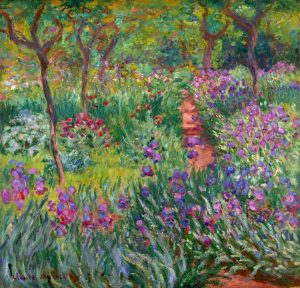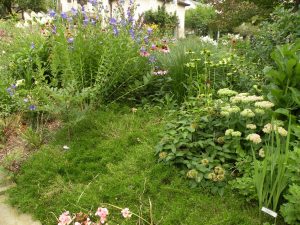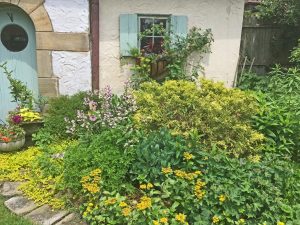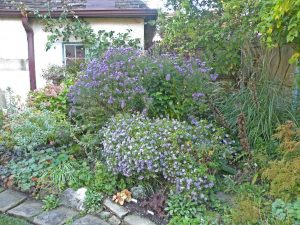
“The Iris Garden at Giverny” by Monet is Monet’s encapsulation of the garden at the moment when he painted it.-wikiart
Gardens are living art. Unlike many of our clients, those of us who garden know that the garden will always need to be tweaked. On the other hand, paintings are stuck in the moment of their creation.
The environment of the garden is rarely static. We may ask why one plant in a grouping dies while the others live but most of the time, we have no ready answer.
There are constant changes in moisture, light, wind, and life. As trees grow or die, the amount of light changes. My east bed used to be very sunny but now is shadier than I would like in the afternoon. I have, therefore, needed to replace sun-loving perennials and shrubs with shade-loving ones.
In addition to environmental changes, our goals and tastes can change over the years. I initially started gardening so that I could have flowers to cut and bring inside, thus foregoing trips to the florist. Instead, I became so enamored of the flowers in the garden, I couldn’t bear to cut them. Then I started dreaming about how to improve the garden itself. That’s just one instance of how goals can change.

My original color scheme was mostly blue, pink and white.
Taste can change too. When I first started gardening and designing, I relied on a color scheme of blue, purple, pink, and white. At that time, I planted Platycodon (Balloon Flower) for its lovely blue color and its unusual balloon-shaped flowers. Little did I know how much maintenance would be involved. The flowers are beautiful when budded and when open but horrendous when done. I swear they look like used condoms.

The addition of yellow and shades of orange have added much more interest to my garden.
As that part of the west bed has evolved, I’ve added yellow Achillea to the pink and orange Echinacea and white Gaura and find that the blue actually detracts so I’ve started taking it out.That led to adding some apricot and then some orange. One of my favorite perennials now is Penstemon barbatus. Once it starts blooming in July, its orangey-red flowers provide strong contrast to the pink of Echinacea and the white of Hydrangea paniculata. That was only the beginning of my affinity for this part of the color spectrum. Belamcanda chinensis is a softer orange as is the my double-flowered poppy but Crocosmia ‘Lucifer’ is in-your-face orange although I tend to place that toward the back with another strong colored perennial, the magenta Geranium psilostemon.

The juniper was pruned in early spring but is still hiding the hydrangea behind it.
When designing a garden, we rely on books and catalogs plus our experience to tell us how large a particular plant will be at maturity. The problem is that plants pay no attention to those strictures. For instance, in my back garden, I have a Juniperus chinensis ‘Eternal Gold. I planted it in 2007 assuming that it would grow no higher than three feet. This was true for the first five years but since then I have struggled to keep it at that height so as not to hide the plants behind it. Now, only time and manpower are keeping me from removing it. I’m tired of pruning it and want a yellow conifer like Juniperus ‘Daub’s Frosted’ that won’t need constant pruning.

Aster ‘Hella Lacy’ and Aster cordifolius ‘October Skies’ the year before I planted the Hibiscus.

Hibiscus ‘Summer Storm’ not overwhelmed by asters.
The books also forgot to mention that New England asters have rhizomatous roots. Many years ago, I planted Aster novae-angliae ‘Hella Lacy’ for its strong purple color and the fact that it was a fall-bloomer. Little did I know that it would try to take over the right back garden. A few years later, I added Hibiscus Summerific ‘Summer Storm’, not realizing that it would grow over the stone path in that part of the garden. This year I decided to stop fighting with them. I dug out most of the aster, leaving only a bit that I will have to watch so it doesn’t spread too much. Then I transplanted the Hibiscus further left away from the path and am waiting for its huge pink blooms to open. I am also widening the path to make maintenance easier.
Over the years, I came to realize that my front gardens needed conifers to help carry them through the winter. I have two cultivars of blue spruce placed asymmetrically, two yellow conifers across the front of the center bed plus one tall one in the back, and some green cultivars of Thuja. These are my “bones”.
What I’ve learned is that we need to constantly assess our gardens and then make necessary changes. I assume that I will keep tweaking my garden forever.


1 Comment